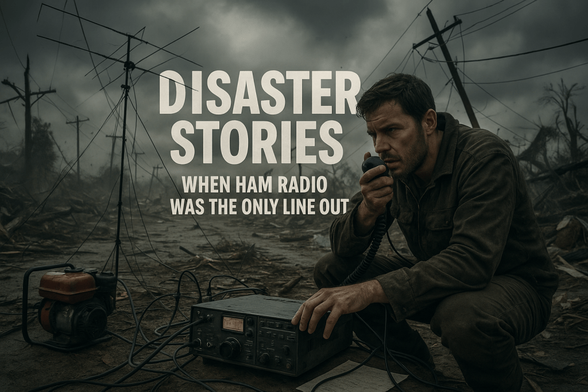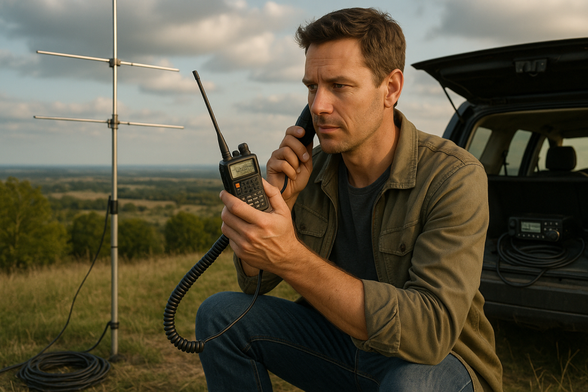Disaster Stories: When Ham Radio Was the Only Line Out
979 words, 5 minutes read time.
In the face of disaster, when power grids fail, cell towers collapse, and the world falls silent, a group of dedicated individuals remains steadfast—amateur radio operators, or “hams.” These men and women, often working quietly behind the scenes, have been the lifeline for countless communities during emergencies. Their stories are not just about radios and frequencies; they’re about courage, community, and the unyielding spirit of service.
The Genesis of Amateur Radio in Emergency Communications
The roots of amateur radio’s involvement in emergency communications trace back to the early 20th century. In 1914, the American Radio Relay League (ARRL) was established, marking a significant step in organizing amateur radio operators. By the 1920s and 1930s, hams were actively engaging in disaster response, providing crucial communication links during floods and ice storms in New Mexico and Minnesota.
The need for organized emergency communication became even more apparent during World War II. In 1942, the Federal Communications Commission (FCC) formed the War Emergency Radio Service (WERS) to ensure that amateur radio could be quickly mobilized in times of national crisis. This laid the groundwork for future emergency services.
The Rise of ARES and RACES
In 1935, the ARRL introduced the Amateur Radio Emergency Service (ARES), aiming to provide organized communication support during emergencies. This initiative was further strengthened in 1952 with the establishment of the Radio Amateur Civil Emergency Service (RACES), a service authorized by the FCC to assist government agencies during civil emergencies.
These organizations have been instrumental in numerous disaster responses. For instance, during the 2003 North America blackout, amateur radio operators played a pivotal role in relaying information and coordinating efforts when traditional communication systems were overwhelmed.
Real-Life Heroes: Ham Radio in Action
The true measure of amateur radio’s impact is best understood through the stories of those who have experienced its benefits firsthand.
During Hurricane Katrina in 2005, over a thousand ARES volunteers provided essential communication services. Hancock County, Mississippi, had lost all contact with the outside world, except through ARES operators who served as 911 dispatchers and message relayers.
Hurricane Michael in 2018 left many areas without power and communication. Amateur radio operators were among the first to establish communication links, coordinating rescue and relief efforts when other systems were down.
During Hurricane Helene in 2024, in Asheville, North Carolina, ham radio operators played a significant role in keeping residents informed during this deadly tropical storm. They provided updates and coordinated emergency responses when electrical grids and telephone communications were disrupted.
The Mechanics of Ham Radio in Emergencies
Amateur radio’s effectiveness in emergencies lies in its unique capabilities. Unlike commercial communication systems that rely on infrastructure vulnerable to damage, ham radios can operate independently. Operators use battery-powered equipment, solar panels, and portable antennas to establish communication links, often without the need for external power sources.
One of the key tools in emergency communications is the use of repeaters. These devices amplify radio signals, extending the communication range, especially in mountainous or obstructed areas. Additionally, digital modes like Winlink allow for the transmission of emails and messages over long distances, even when traditional internet services are unavailable.
Training and Preparedness: The Backbone of Emergency Response
The readiness of amateur radio operators is a result of continuous training and preparation. Events like Field Day, held annually, simulate emergency conditions, allowing operators to practice setting up equipment and establishing communication links without relying on commercial power sources. These exercises ensure that when real disasters strike, operators are prepared to respond swiftly and effectively.
Organizations such as ARES and RACES provide structured training programs, ensuring that volunteers are equipped with the necessary skills and knowledge to handle various emergency scenarios. Their involvement is crucial in maintaining a state of preparedness within communities.
The Future of Ham Radio in Disaster Response
As technology advances, so does the role of amateur radio in emergency communications. The integration of digital modes, satellite communications, and software-defined radios enhances the capabilities of ham operators, allowing for more efficient and reliable communication during disasters.
Legislative support also plays a vital role in ensuring the continued effectiveness of amateur radio. Initiatives like the Amateur Radio Emergency Preparedness Act aim to prevent homeowner associations from banning amateur radio antennas, ensuring that operators can maintain their equipment and remain ready to assist during emergencies.
Conclusion: A Call to Action
The stories of amateur radio operators during disasters are a testament to the power of community, preparedness, and resilience. Their unwavering commitment ensures that when all else fails, communication remains possible.
For those interested in becoming part of this vital network, obtaining an amateur radio license is the first step. By doing so, you not only gain the skills to operate radio equipment but also become a crucial link in a chain that can make all the difference during emergencies.
To learn more about amateur radio and how you can get involved, consider subscribing to our newsletter at https://wordpress.com/reader/site/subscription/61236952 or joining the conversation by leaving a comment, or contact me using the contact form at https://bdking71.wordpress.com/contact/.
D. Bryan King
Sources
- A Brief History of the Amateur Radio EmComm Organization
- Amateur Radio Emergency Service – Wikipedia
- Ham Radio History – ARRL
- Stories about Amateur Radios and Emergency Rescue
- Amateur Radio Emergency Communications – Wikipedia
- Amateur Radio and Emergency Communications – AlertFind
- Ham Radio: A Valuable News Source Especially During Emergencies
- History – CCARES
- Hamming It Up – The Planet Magazine
- Ham Radio Emergency Communications Guide – Ham Radio Prep
- History of ARES and NTS
- Ham Radio Serving Southeast US Recovery Efforts
- Unleashing the Power of Amateur Radio in Times of Emergency
- Amateur Radio Emergency Communication: Lifeline in Crisis
Disclaimer:
The views and opinions expressed in this post are solely those of the author. The information provided is based on personal research, experience, and understanding of the subject matter at the time of writing. Readers should consult relevant experts or authorities for specific guidance related to their unique situations.
Related Posts
Rate this:
#AmateurRadio #amateurRadioCallToAction #amateurRadioClubs #amateurRadioCommunicationMethods #amateurRadioDisasterHistory #amateurRadioEmergencyCases #amateurRadioEmergencyTips #amateurRadioHistory #amateurRadioLicense #amateurRadioLifeSaving #amateurRadioNetwork #amateurRadioNetworking #amateurRadioNews #amateurRadioOutreach #amateurRadioPreparation #amateurRadioPreparedness #amateurRadioRescue #amateurRadioRescueStories #amateurRadioSatelliteCommunication #amateurRadioService #amateurRadioTraining #amateurRadioVolunteerStories #antennaSetup #ARES #batteryPoweredRadio #communicationLifeline #communicationsDuringBlackout #communityRadioService #digitalRadioModes #disasterCommunication #disasterCommunicationExamples #disasterCommunicationTips #disasterRelief #DisasterResponse #disasterStorytelling #earthquakeCommunication #EmergencyCommunication #emergencyCommunicationStrategies #emergencyCommunicationSystems #emergencyCommunicationsNetwork #emergencyMessaging #emergencyOperator #emergencyOperatorTraining #EmergencyPreparedness #emergencyPreparednessTraining #emergencyRadio #emergencyRadioTraining #emergencyResponse #emergencyVolunteer #fieldDay #floodCommunication #hamRadio #hamRadioAntennaTips #hamRadioBenefits #hamRadioCommunity #hamRadioCommunitySupport #hamRadioDigitalModes #hamRadioEmergencyExercises #hamRadioEmergencyService #hamRadioEquipment #hamRadioFieldDayTips #hamRadioFieldOperations #hamRadioHero #hamRadioHeroStories #hamRadioHistoryTimeline #hamRadioInAction #hamRadioInspiration #hamRadioLicense #hamRadioNewsCoverage #hamRadioRealStories #HamRadioSafety #hamRadioStories #hamRadioSurvivalSkills #hamRadioTechnicalGuide #hamRadioTechnology #HamRadioTraining #hamRadioVolunteer #HFRadio #hurricaneCommunication #portableRadio #RACES #radioDisasterExamples #radioEmergencyPreparedness #radioEmergencySupport #radioForEmergencies #radioInCrisis #radioOperator #radioOperatorSkills #radioSkills #repeaters #solarPoweredRadio #SurvivalCommunication #UHFRadio #VHFRadio #volunteerRadioOperator #Winlink

